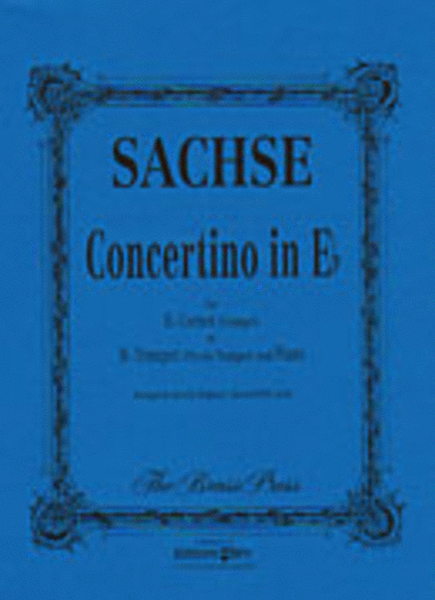Concertino in Eb
-
Ships in 3 to 4 weeks
Details
Description
SKU: ET.TP167A
Composed by Sachse. Arranged by Stephen L. Glover. Romantic. Piano (reduction). Composed 1871. Duration 14'. Editions BIM #TP167A. Published by Editions BIM (ET.TP167A).ISBN 9790207018014.
Sachse's Concertino in E-flat was published by G.W. Stratton at Boston in 1871 as "No. 610, Concertino for E-flat Cornet" of the Military Band, Sixth Series. The original instrumentation is:
E-flat Cornet Solo
2 Cornets in B-flat
3 Altos in E-flat
2 Tenors [bass clef]
Baritone [bass clef]
Basses [divisi]
The work is one of a number of military (brass) band pieces published as oblong scores by Stratton. The original is presently at the Library of Congress in Washington, D.C. The Concertino in E-flat is unique among the other Stratton military band publications there in several respects. First, it is for Solo E-flat Cornet accompanied by a full brass band. The majority of the other works are for numerous combinations of brass quartets (E-flat cornet, B-flat cornet, tenor and baritone; B-flat cornet, E-flat alto, tenor, and baritone; two E-flat altos, tenor, and baritone; 2 tenors, baritone, and bass; and other combinations). Secondly, it is more developed musically than the other pieces which are mostly short arrangements by composers such as Schumann, Mendelssohn, Haydn, Hensel, Hauptman, Hiller, and others. Third, it seems likely that it is in its original form and is not an arrangement. Unfortunately, the composer is identified only as Sachse, and it is impossible to speculate as to the composer's first name at this time.
George William Stratton (born August 1, 1830, in West Swanzey, New Hampshire — died October 14,1901 in Berlin, Germany) became interested in music at the age of seven when he studied the clarionet. At the age of nine he performed in a travelling troupe with his brother John F. playing trombone, and by age ten he showed an interest in composing. After formal music training he became a "teacher of music" in 1852. He later published several of his compositions which were economically successful. From 1866 to 1891 his principal business was that of a wholesaler of general musical merchandise in Boston. The business was prosperous enough that he spent much of his time after 1874 travelling about Europe and Africa. He crossed the Atlantic thirty-five times. He built and gave to his hometown of Swanzey the Stratton Free Library and Art Gallery (1885). While George W. had made a study of brass instruments, the Military Band series he published must have been influenced by his brother John F. Stratton. In 1859 it was not possible to purchase, in the United States, a ready-made set of band instruments. To obtain such a set, a special order had to be made. It took months to manufacture the set, and the cost was high because only two or three of each instrument were made at one time (i.e., cornet, alto, tenor, baritone, bass). John F. decided to manufacture each of the band instruments in quantity to reduce the cost. His rotary valve instruments were made first and then sold rather than being made as special orders.
During the Civil War, John F. furnished 60,000 army bugles and trumpets, and 120,000 mouthpieces to the United States Government from his New York City factory. Ten tons of brass were used for the mouthpieces.
In 1866 John F. moved his brass factory to Markneukirchen in Saxony, and the following year he opened a general musical merchandise import store in New York. By 1870 he opened the world's largest violin factory in Gohlis.
It seems likely that the Military Band series grew from the interests which George W. had in composing and publishing and which John F. had in brass instruments.

 Share
Share